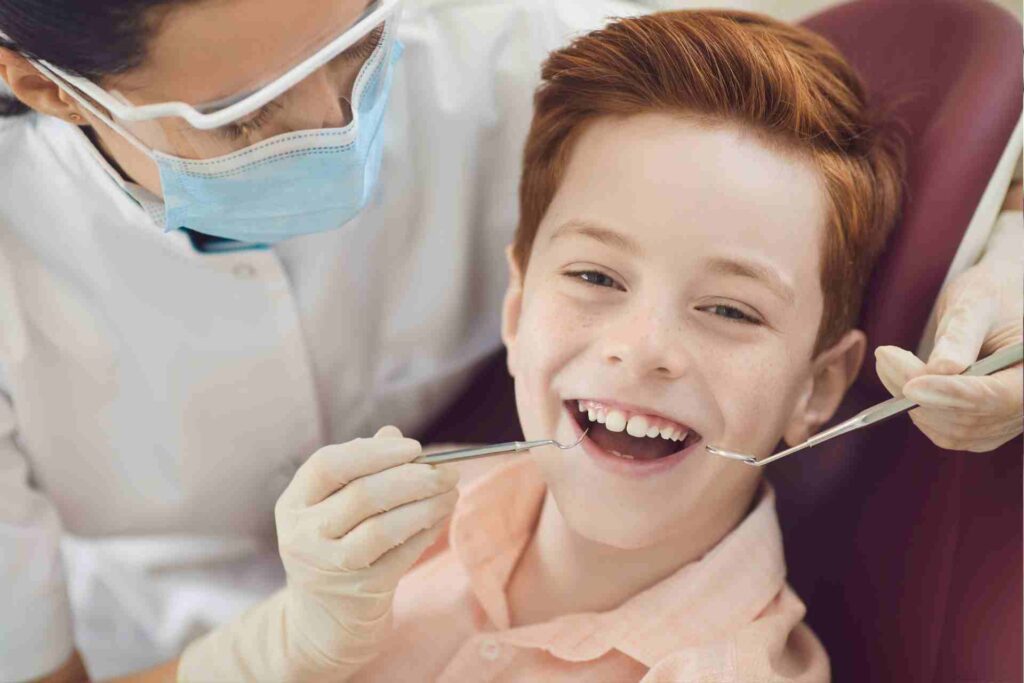Highlights:
- First permanent molars, also known as “six-year molars,” usually appear between ages 6 and 7.
- By age 13, most children have all 28 permanent teeth, excluding wisdom teeth.
- Wisdom teeth, or third molars, typically emerge between ages 17 and 21.
- Timely eruption of permanent teeth is vital for proper alignment and oral function.
- Regular dental check-ups ensure healthy development and early issue detection.
Permanent teeth are critical for chewing, speaking clearly, and even supporting facial structure. Understanding when these teeth usually come in can help you stay on top of your child’s dental health and catch any potential issues early, setting the stage for a lifetime of healthy smiles.
Timeline of Permanent Teeth Eruption
Permanent teeth follow a sequential eruption pattern, typically beginning around age six and continuing into early adulthood.
Early Childhood (Ages 6-7)

At this stage, kids start losing their baby teeth and getting their permanent ones. These first teeth are really important for helping their jaws grow properly and keeping everything aligned.
First Molars (“Six-Year Molars”)
Eruption Age: Typically between ages 6 and 7
Location: Erupt behind the existing primary molars
Significance:
- Do not replace any baby teeth—they come in behind them.
- Serve as key anchors for the rest of the permanent teeth.
- Essential for proper bite alignment and chewing function.
Tip: These molars are prone to cavities—early dental sealants can help protect them.
Central Incisors
Eruption Age: Usually between ages 6 and 7
Location: Front and center in both the upper (maxillary) and lower (mandibular) jaws
Significance:
- Replace the primary central incisors (the first baby teeth that fall out).
- Play a crucial role in biting and speaking clearly.
Tip: Gentle wiggling of loose baby teeth can help the permanent ones come in smoothly—avoid pulling too soon.
Middle Childhood (Ages 7-9)
As children progress into middle childhood, the next set of permanent teeth emerge, continuing the transition from baby teeth to a more mature smile. This stage focuses on the lateral incisors, which play an important role in both function and appearance.
Lateral Incisors
Eruption Age: Typically between ages 7 and 9
Location: Positioned next to the central incisors in both the upper (maxillary) and lower (mandibular) jaws
Significance:
- Replace the primary lateral incisors that typically fall out between ages 7 and 8.
- Help with biting, tearing food, and guiding the alignment of surrounding teeth.
- Contribute to the overall aesthetics of the smile.
Tip: Keep up with good oral hygiene during this stage to prevent cavities in the newly erupted permanent teeth.
Pre-Adolescence (Ages 9-12)

During pre-adolescence, children experience a significant phase in permanent teeth eruption. The arrival of canines and premolars is essential for proper chewing, biting, and jaw alignment.
This stage also contributes to the overall balance and appearance of the smile.
Canines (Cuspids)
Eruption Age: Typically between ages 9 and 12
Location: Positioned beside the lateral incisors and before the premolars in both the upper (maxillary) and lower (mandibular) arches
Significance:
- Replace the primary canines (baby cuspids).
- Known for their sharp, pointed shape designed to tear and grip food.
- Guide the alignment of surrounding teeth and support facial structure.
- Play a key role in maintaining a balanced bite.
Tip: Early detection of any crowding around the canines can prevent future alignment issues—consult your dentist if you notice delayed eruption.
First and Second Premolars (Bicuspids)
Eruption Age:
- First Premolars: Usually between ages 10 and 11
- Second Premolars: Typically between ages 10 and 12
Location: Situated between the canines and molars, replacing the primary molars
Significance:
- Designed for crushing and grinding food, aiding in digestion.
- Help maintain proper spacing and support the overall alignment of the dental arch.
- Essential for achieving a functional and comfortable bite.
Tip: Keep an eye on the eruption pattern of premolars—misalignment or delayed eruption may require early orthodontic evaluation.
Early Adolescence (Ages 11-13)
By early adolescence, most children are nearing the completion of their permanent teeth eruption (excluding wisdom teeth). One of the key developments during this stage is the emergence of the second molars, also known as the “twelve-year molars.”
Second Molars (“Twelve-Year Molars”)
Eruption Age: Typically between ages 11 and 13
Location: Erupt directly behind the first molars in both the upper (maxillary) and lower (mandibular) jaws
Significance:
- Play a crucial role in chewing, grinding food, and maintaining proper bite function.
- Help stabilize the alignment of the other permanent teeth.
- Serve as a key part of the dental arch’s foundation for long-term oral health.
Tip: Because these molars emerge in hard-to-reach areas, focus on good brushing and flossing habits to prevent cavities. Dental sealants can offer added protection.
Late Adolescence to Early Adulthood (Ages 17-21)

The final stage of permanent teeth eruption occurs during late adolescence and early adulthood with the emergence of the third molars, commonly known as wisdom teeth.
While not everyone develops them, they can have significant implications for oral health.
Third Molars (Wisdom Teeth)
Eruption Age: Typically between ages 17 and 21
Location: Erupt at the very back of the upper (maxillary) and lower (mandibular) jaws, behind the second molars
Significance:
- Can aid in chewing if properly aligned and healthy.
- Some individuals may not develop all four wisdom teeth, and others may have none at all.
Common issues:
- Impaction: Teeth become trapped under the gums or jawbone, potentially causing pain or swelling.
- Crowding: Wisdom teeth can push against neighboring teeth, disrupting alignment.
- Infection risk: Partially erupted wisdom teeth are prone to gum infections and cavities.
Tip: Regular dental X-rays in the late teens help monitor wisdom teeth development. Early removal is often recommended if they pose risks to oral health.
Note: Eruption timelines can vary; regular dental visits are essential for personalized assessments.
Factors Influencing Tooth Eruption
While permanent teeth generally follow a typical timeline, several factors can influence the timing and sequence of their eruption. Recognize what’s normal and when to consult a dentist.
Genetics
- Family history plays a significant role in tooth eruption patterns.
- If parents experienced early or late tooth development, their children may follow similar timelines.
- Genetics can also influence tooth size, shape, and alignment, affecting how and when teeth emerge.
Tip: If you notice delayed eruption and have a family history of similar patterns, mention it during dental visits.
Nutrition
- Adequate intake of essential vitamins and minerals—especially calcium, phosphorus, and vitamin D—is crucial for healthy tooth and bone development.
- Malnutrition or deficiencies can lead to delayed eruption or weakened tooth structure.
- Encourage a balanced diet that includes dairy products, leafy greens, and fortified foods to support oral health.
Tip: Pairing a calcium-rich diet with proper vitamin D intake improves calcium absorption for stronger teeth.
Oral Hygiene

- Good oral hygiene practices from an early age help prevent infections like gingivitis or abscesses, which can delay or disrupt tooth eruption.
- Poor hygiene can lead to early tooth loss or gum problems, affecting how permanent teeth come in.
- Teaching children to brush twice a day, floss regularly, and visit the dentist sets the foundation for timely tooth development.
Tip: Dental check-ups every six months help detect early signs of issues that could affect tooth eruption.
Early Loss of Primary Teeth
- Premature loss of baby teeth, often due to injury or decay, can cause shifting of surrounding teeth.
- Without proper space, permanent teeth may erupt misaligned, become impacted, or fail to emerge on schedule.
- Dentists may recommend space maintainers to keep proper alignment if a primary tooth is lost too early.
Tip: If your child loses a baby tooth before age 5, consult your dentist to prevent future alignment issues.
Monitoring and Supporting Healthy Eruption
Regular Dental Check-Ups
- Schedule dental visits every six months to track tooth eruption progress.
- Dentists use X-rays and visual exams to monitor the positioning of emerging teeth.
- Early detection of issues like crowding, impaction, or delayed eruption enables timely treatment.
Tip: Regular check-ups also provide an opportunity to apply dental sealants or fluoride treatments for added protection.
Balanced Diet
- A nutrient-rich diet supports healthy tooth and bone development.
- Focus on foods high in:
- Calcium: Dairy products, leafy greens, and fortified plant-based milks
- Phosphorus: Meat, fish, eggs, and nuts
- Vitamin D: Fortified foods and safe sun exposure to improve calcium absorption
- Limit sugary snacks and acidic drinks to prevent enamel erosion and cavities.
Tip: Encourage your child to drink water after meals to help rinse away food particles and acids.
Oral Hygiene Education
Teach children to:
- Brush twice daily with fluoride toothpaste
- Floss once a day to clean between teeth
- Use age-appropriate toothbrushes for effective cleaning
Supervise brushing until at least age 7 to ensure thoroughness.
Tip: Make oral care fun with colorful brushes, flavored toothpaste, and reward charts.
Protective Measures

- Dental injuries can delay tooth eruption or damage developing teeth.
- Use mouthguards during contact sports like soccer, basketball, or martial arts.
- Encourage safe play habits and discourage chewing on hard objects (like ice or pens).
Tip: Custom-fitted mouthguards from your dentist offer better comfort and protection than store-bought options.
Common Concerns and When to Seek Advice
Delayed Eruption
What to watch for:
- Permanent teeth that fail to emerge within six months of the expected timeframe.
- Baby teeth that don’t fall out on schedule, blocking the eruption of permanent teeth.
Possible causes:
- Genetic factors
- Nutritional deficiencies
- Impaction or obstruction from other teeth
- Underlying medical conditions
When to seek help: If you notice a significant delay in eruption, consult your dentist. X-rays can identify if a tooth is impacted or developing incorrectly.
Eruption of Extra Teeth (Supernumerary Teeth)
What it is:
- Supernumerary teeth are extra teeth that develop beyond the normal set of 32 permanent teeth.
Why it matters:
- These extra teeth can block or delay the eruption of permanent teeth.
- They may cause crowding, misalignment, or bite issues.
When to seek help: If you notice an unexpected tooth appearing, schedule a dental appointment for evaluation and possible removal.
Misalignment or Crowding
What to watch for:
- Teeth erupting at odd angles or overlapping neighboring teeth.
- Lack of space for permanent teeth to emerge properly.
- Shifting teeth that affect your child’s bite and overall alignment.
Why it matters:
- Crowded or misaligned teeth can make cleaning difficult, increasing the risk of cavities and gum disease.
- Severe misalignment may impact speech, chewing, and jaw development.
When to seek help: Early orthodontic evaluation (around age 7) can determine if braces or other treatments are needed.
When in Doubt, Consult Your Dentist

If you notice any of the above concerns or have questions about your child’s dental development, don’t hesitate to seek professional advice. Early intervention can prevent more serious problems down the road and ensure a healthy, well-aligned smile.
Key Takeaways
- Permanent teeth eruption typically begins around age 6 and continues into early adulthood.
- Awareness of eruption timelines aids in proactive dental care.
- Genetics, nutrition, and oral hygiene significantly influence tooth development.
- Regular dental visits are essential for monitoring progress and addressing concerns.
For more family-friendly dental tips and expert advice, follow @joycethedentist!
FAQs
At what age do children typically get their first permanent tooth?
Around age 6, with the eruption of the first molars or central incisors.
Is it normal for permanent teeth to come in before losing all baby teeth?
Yes, this mixed dentition phase occurs between ages 6 and 12.
What should I do if my child’s permanent tooth is coming in crooked?
Consult a dentist; early evaluation can determine if orthodontic treatment is needed.
Are there any signs that indicate problems with tooth eruption?
Prolonged delays, pain, or swelling warrant a dental visit for assessment.
How can I help my child manage discomfort during tooth eruption?
Over-the-counter pain relievers and oral gels can alleviate discomfort; consult your dentist for recommendations.





















